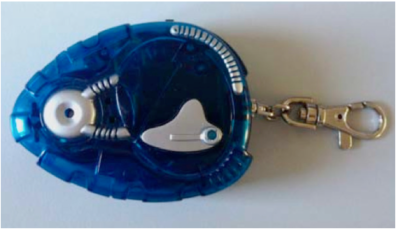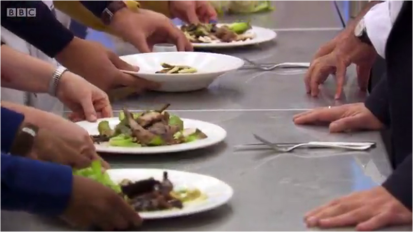By Jeżyna Domańska
Learning by exploring is an old, and very fun, method for learning. Who prefers reading a long manual of a device or program they just acquired, rather than just clicking around to see what happens? Who hasn’t opened up some device at least once, just to see how it looks inside?
Both Murer et al. [2] and Davoli et al. [1] include exploring as a part of the design process, in different ways and using very different examples. In this essay I would like to analyse what those two papers have in common, and what we can, as HCI students, learn from them to (hopefully) become better designers.

Figure 1. The unknown device analysed in Murer et al.
Murer et al. [2] introduced a concept of ‘taking things apart’ – which means literally what it says. The authors had stumbled upon a small device of unknown purpose and origin (fig. 1), and put together a small team consisting of a maker and a designer. The idea was to disassemble a device, analyse its components, and figure out what it does. To oversimplify their conclusions, they learnt a lot about the material they had been working with, based both on the hands-on exploration and from a clash of perspectives from the experts from different fields.

Figure 2. Contestants of MasterChef presenting their results on the Palate Test.
The idea of ‘taking things apart’ is not a new concept. For example, in the TV show MasterChef UK, one part of the competition is a task called ‘The Palate Test’. The participants are presented with a plate containing a complex dish. They are given a pen and a piece of paper, and some time to figure out what ingredients and methods to use to recreate the dish. To figure it out they can look at it, smell it, taste it, analyse its texture, etc. Later, they need to recreate the dish as accurately as they can, or at least some crucial components of it, preferably better than the other competitors.
This resembles the ‘material talks back’ concept, as presented by Schön [3]. He explained that designers “see, move, and see again”. The way I understood it, is that ‘seeing’ is the first interpretation of the material available, ‘moving’ is creating something with the material, and ‘seeing’ again is discovering the consequences of their changes. So the contestants of MasterChef first ‘see’ their dish – ‘see’ is an understatement, since they use multiple senses to assess what they have. Then they ‘move’ – so they cook their dish, and then they ‘see’ again – which in that sense could be assessing while cooking to see where their approach is taking them so far and adjusting their method. The final ‘seeing’ is comparing their dish with the original and getting conclusions on what they’ve done wrong. They are learning their dish the same way as design team for Murer et al. has learned their device.
What the article gave us, are insights into why using this approach is useful – creating a common ground, shared material knowledge, and a material brief. Of course, doing that is a great tool for learning, and it helps to get to know the material very well. However, I am not sure when to use the technique of actually stripping down the device. Murer et al. [2] have done it simply as a design exercise, and in the MasterChef task the purpose was to recreate something, a task which is not a common problem for designers to solve, since designers usually have to come up with something new. So where else could we use the equivalent of ‘taking things apart’ technique?
In their paper, Davoli et al. [1] present a study of how to design for a process whose details are inaccessible to them. They wanted to redesign a package delivery system which was working inefficiently, taking their starting point as the processes used by delivery companies. However, those companies didn’t provide information on how their systems worked, which pushed the authors to use rather unusual methods of gaining data. They created ‘Trojan packages’ (fig. 3), which were containing two tracking systems and a camera recording the surroundings of the package. Participants were recruited, and multiple packages were send out to gather the data on the journey of the packages, in order to ‘crack’ the delivery system. So they also performed ‘taking apart’, only not on a device, but on a process. They saw – in that case it could mean seeing the need for fixing the delivery system and discovering that the inside look into the delivery companies is inaccessible. Then they moved, which was creating a tracking system, and then they saw again, which was analysing their findings and coming to the conclusions.
My conclusion is that involving a hands-on, physical exploration in the early phases of the design process can provide interesting and unique insights into the design material, or the problem that the design aims to tackle. I very much enjoy the idea of starting the research by doing an exploration of the problem, not just observing it or asking straightforward questions to people that could explain it.
However, as illustrated by these studies, such exploration won’t be enough. Both of the examples presented in the paper failed to really grasp the purpose of the things they were exploring. Murer et al. clearly stated that they didn’t discover what to use the device for, and Davoli et al. proved that the way of delivering the packages was inefficient, but they didn’t find out why the packages were travelling the way they were, and a company certainly had some system for that. So such exploration could be a good start, but should be followed (if possible) by more inquires, such as interviews, etc., to get the information that is lacking.
It is possible that the idea of incorporating such exploration might be a bit idealistic. In the articles, using those approaches was a necessity, but in design problems there are usually simpler methods available, such as contextual interviews. Without an actual design problem to solve I can’t provide guidelines on how to incorporate material explorations, or to what extent. However, it seems tempting to try to explore the design material or the environment by including some form of what is expected in the design to come.
References
- Davoli, Lorenzo, and Johan Redströ “Materializing infrastructures for participatory hacking.” Proceedings of the 2014 conference on Designing interactive systems. ACM, 2014.
- Murer, M., Jacobsson, M., Skillgate, S., & Sundström, P. (2014, April). Taking things apart: reaching common ground and shared material understanding.
In Proceedings of the SIGCHI Conference on Human Factors in Computing
Systems (pp. 469-472). ACM. - Schön, D.A., Designing as reflective conversation with the materials of a design situation. Knowledge-Based Systems 5, 1 (1992)
Images
- Murer, M., Jacobsson, M., Skillgate, S., & Sundström, P., 2014 – p. 1
- http://www.bbc.co.uk/iplayer/episode/b05rhtyw/masterchef-series-11-episode-18 – 47:14

